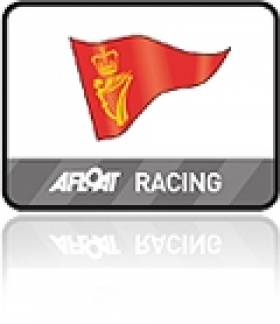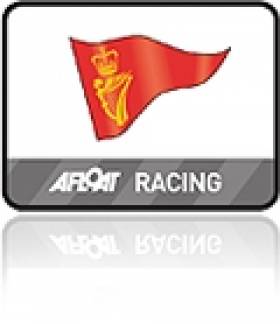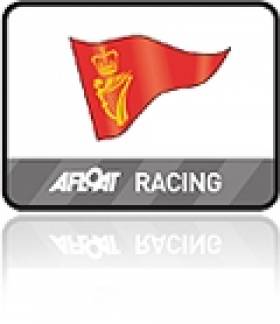Displaying items by tag: Royal Cork Yacht Club
#royalcork – The Royal Cork Yacht Club has twinned with Yacht Club de Monaco (YCM) and a reception to mark the occasion was held in YCM on Sunday, June 28th at 17.30 hours writes Claire Bateman. YCM have reciprocal arrangements with fifty one clubs worldwide but only have Twinning Agreements with fifteen. Royal Cork Yacht Club is the only yacht club in Ireland or the U.K. to have such a Twinning Agreement and is the first club to have been invited to Twin with YCM since 2006.
Royal Cork Yacht Club General Manager, Gavin Deane, travelled to Monaco to attend the lavish reception in the newly built yacht club (opened June, 2014), hosted by His Serene Highness Prince Albert II, President YCM. The reception had a dual purpose, to celebrate the Twinning with the Royal Cork Yacht Club and to host new members to the club. The reception was attended by 1500 people and was followed by a dinner for 200 invited guests.
Gavin met with HSH Prince Albert II, President YCM, Bernard d'Alessandri, General Secretary/Director YCM and the Club's Board Committee at a private reception in the Club. HSH Prince Albert II and Gavin Deane signed the Twinning Agreement, exchanged framed Club burgees, Club history books and Club ties.
Outline of agreement: "The two Clubs base the agreement upon a reciprocal engagement to mutually support and promote the Clubs' Sporting Programmes and Social Events. Members of the two Clubs shall benefit from the Structures and Services offered by each Club in conformity with agreed regulations".
The relationship between the Clubs has flourished over the past five to six years as Royal Cork Yacht Club sends an Optimist team to race at an event in Monaco every January.
Other RCYC members that joined Gavin at the event were Eddie Jordan (F1 fame) and Harry Gibbings (originally from Cork), both of whom reside in Monaco and are overseas members of Royal Cork Yacht Club.

HSH Prince Albert II, President YCM, recently became a member of the Royal Cork Yacht Club, and when General Manager Gavin was introduced to him he proudly produced his Royal Cork Membership card from his pocket.
Speaking with Gavin as he very eloquently described his visit to Monaco, one could almost feel as if one were there and it certainly seemed to live up to all the wonderful tales one hears about the Principality . He described the beautiful azure sea and the marinas filled with exotic and wonderful craft of all types and sizes and the beauty of the architecture and buildings, and the friendliness of the people. The temperature was some 30 degrees and all in all appeared to be a dream location.
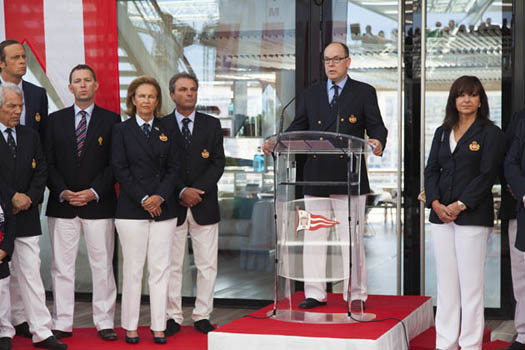
The twinning of the two yacht clubs brings our relationship with Monaco even closer. Monaco is held in very high esteem by the Irish people and particularly through the deep affection felt for the late HSH Princess Grace of Monaco, wife of the late Prince Rainier of Monaco. They brought their family to visit Ireland and and Princess Grace also made other visits here. She was very interested in and proud of her Irish ancestry and was greatly admired by the Irish people for her charm and beauty.
Lough Erne J24 Wins Royal Cork Southern Championships
#j24 – With four race wins from six race sailed the furrthest travelled J24 won the class southern championships at Royal Cork Yacht Club (RCYC) today. Lough Erne's JP McCaldin from County Fermanagh in Northern Ireland beat the Royal St.George's Hard on Port skippered by Flor O'Driscoll. Third was Howth Yacht Club's Kilcullen (Gordon Stirling). Full results in the seven boat fleet are downloadable below.
Saturday morning South of Roche's Point saw a breeze of 18 to 20 knots for the first race of the J24 Southern Championship. Race Officer Ciaran McSweeney kept everybody on their toes, sounding the first gun at 10.30 as posted, catching a few competitors off guard. JP McCaldin and his crew on Jamais Encore dominated the first race with local boat YaGottaWanna showing good boat speed to claim a second place. Current Irish Champion FlorO'Driscoll claimed third place with Patrick Crosbie helming his youth team over the line ahead of the Howth Yacht Club under 25 crew.
The battle of the start line was more intense in race 2, with Howth Yacht Club and Jamais Encore stealing a march on the fleet on the first upwind leg of the windward / leeward course. The first run saw Flor O'Driscoll joining the early leaders, engaging in a duel up the next beat with HYC. The finishing places confirmed the credentials of gold fleet, with Jamais Encore, HYC and Hard on Port taking the podium.
The breeze was building by the start of race 3, and the local youth team changed from the overlapping genoa to a jib, a decision which proved to be inspired, as we watched them make their way up the racecourse, to finish close on the heels of the gold fleet boats. All the competitors followed suit with the foresail change for the last race of the day, in challenging gusty conditions. An unfortunate collission in race 4 between HYC and YaGottaWanna resulted in HYC retiring, and YaGottaWanna limping home with a hole in her aft quarter. Conor Haughton's team from the National Maritime College kept the local spirits high, with a 4th place finish.
The breeze held for the second day of racing with the race officer deciding to move the fleet to Cuskinny in the hopes of a flatter sea. All competitors opted for a jib for the first race with heavy gusts funneling up towards east ferry. Jamais Encore maintained her winning ways, bagging a third place to add to her 4 bullets in the 6 race series, and opting to withdraw from the last race to expedite hauling out, ready for the long road home to Lough Erne.
Tide became more of a prominent force in the lulls for race 6 with some boats opting to be brave and changing back to a genoa. HYC pulled out a sizeable lead on the first downwind leg only to see the lion's share of it disappear on the second beat. Another entanglement between HYC and YaGottaWanna at the leeward mark saw positions change again. Jelignite claimed their first bullet in a regional championship, a fantastic result for Finbar Ryan, and the young girls on his crew.
The crews sailed back to Crosshaven, passing the magnificent display of the Traditional Sail Fleet bathed in the sunlight of our harbour. After hauling out, all competitors enjoyed the hospitality of the club, and showed their appreciation of Kieran O'Connell for his hard work in providing a brilliantly run championship. We hope it will be an annual event here in RCYC. JP.McCaldin expressed his enjoyment of the event and the beauty of the harbour, while accepting his First Prize in gold fleet and overall J24 Southern Champion, wondering why it had taken him so long to race in RCYC. Hard on Port claimed second overall, with HYC completing the honours in the gold fleet. Local boat YaGottaWanna were delighted with their first place in silver fleet, and were highly impressed by the performance of the local youth team in a very tweaky unfamiliar boat.
#j109 – It's all smiles after the first day of the UK J/109 National Championship, with Ian Nagle's team from the Royal Cork Yacht Club scoring two bullets on J/109 Jelly Baby. "We had a great start in the first race, which put us in a good shape but we had a shocking start in the second and had to fight back from a very poor position, Nagle said.
The Cork Harbour boat, returns to Irish waters for the ICRA Nationals in Kinsale later this month, and has already tasted UK success this season lifting the vice–Admiral's Cup in Cowes in May.
The core of the Jelly Baby team has been together since they started racing the J/109 in 2008 and that experience means that they have built up a lot of knowledge about how to sail fast. 'I have to admit our boat speed was very good today. This has been a very encouraging start and we hope to build on that tomorrow', Nagle said.
First of the New National 18s Arrive on Cork Harbour
#national18 – There's great excitement around Cork Harbour this week with the delivery of the first four of the completely new Phil Morrison-designed National 18s to join the established fleet at Monkstown Bay SC.
In the near future, other boats will be arriving to make their debut as Crosshaven with the Royal Cork YC, as well as further augmenting the Monkstown group. By the time the class's big British and Irish Championship is staged at Royal Cork from July 26th to 31st, the necessary critical mass of the new boats should have been achieved to provide top quality racing. But there will of course also be special provisions made to ensure that boats of older types (the restricted class has been in existence since 1938) are continuing to get worthwhile sport.
The development of this newest and very exciting National 18 has been largely powered by the Cork Harbour National 18ft Class Association, and National 18 sailors in Britain have been particularly impressed by the way that the Royal Cork YC invested funds to help this community effort towards a brighter future from resources within the class association.
This weekend will see the four new boats getting their rigs tuned with some trial sailing planned, but we'll be very surprised indeed if there isn't a test race or two down Monkstown way on Saturday and Sunday.


These boats will take a bit of getting used to, but there's no doubting the excitement in the air...
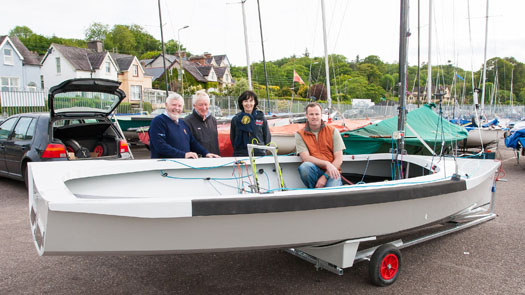
Big smiles greet Colin Chapman's new Ultra Design National 18 one of the first eight National 18's new design to arrive at the Royal Cork Yacht Club for the 2015 season.
L. to R. Royal Cork Admiral Pat Lyons, Dom Long, President National 18 Class, Rear Admiral Dinghies, Celine McGrath and owner Colin Chapman. Picture Robert Bateman.

#sb20 – After an exhilarating day of SB20 sportsboat racing sailed on Cork harbour's Eastern Bank at Royal Cork Yacht Club, only one point separated Darren Martin's Sharkbait and Aidan O'Connell's Ruby Blue going into today's final rounds writes Claire Bateman. Yesterday had seen some scary episodes including Justin Burke's deck lifting from the hull of his boat 'Alert Packaging'.

A relaxed Sharbait crew returning to shore without having had to sail the final race. Photo: Bob Bateman
Todays forecast was for very light wind and this indeed turned out to be the case. However, the 11-boat fleet headed outside the harbour to try to get the best of any wind going and indeed the first race of the day was started but abandoned just before the weather mark as the wind had died completely. However, a new breeze of some 8 to 10 knots arrived to save the day and resulted in a win for Sharkbait and thus negated the need for them to sail the final race.
Results downloadable below.
#2K – Eight teams from Italy, The Netherlands, Germany, Great Britain and Ireland gathered at the Reale Club Tevere Remo, Rome for the first 2K tour event of 2015. Two days of intense round robin racing saw a three way tie break at the top between Cork, YYCS and Spinnaker.
The final day on Sunday started with rain and no wind but PRO Constanzo Villa managed to get in 4 of the critical race to complete the round robin. The final saw last year's runner up Royal Cork face YCCS. It was the Italians who emerged as winners in a sun drenched final.
Final Results
1st Yacht Club Costa Smeralda
2nd Royal Cork
3rd Spinnaker
4th Dutch Match and Team Racing Association
5th Rome Racing Team
6th Royal Thames
7th Serpentine racing
8th Bavaria Yacht Club
Union Chandlery to Sponsor 1720 Euros at Royal Cork
#1720 – No sooner had Baltimore Sailing Club announced its 1720 National Championships last week than Royal Cork Yacht Club unveils its Union Chandlery sponsored 1720 European Championships to be held in the first week of September.
The nine race regatta will run from September 3rd to 5th and the proposed schedule of races is: Thursday 3rd of September up to four races; four more on Friday, concluding with one final race on Saturday.
More details in the NOR downloadable below.
#national18 – Since being introduced to the public at the RYA Suzuki Dinghy Show in March of this year, the first of the new Phil Morrison designed National 18s has been undergoing sailing trials and completing the required EU stability tests. From the moment she hit the water for her inaugural sail at Brightlingsea it was clear that the boat was something special, say her promoters.
Afloat.ie covered recent developments in the class here when WM Nixon concluded the National 18s were taking dinghy racing onto a new plane.
British Olympian Rob White, whose company White Formula builds the boats, was among the first to helm her and couldn't keep the grin off his face. "She's seriously slippery," said Rob immediately after sailing "she feels really responsive and accelerates instantly in even the lightest puffs."
As well as impressing with her sailing performance the new National 18 also passed her EU RCD stability tests with flying colours. Named Hurricane after the very first ever National 18 launched in 1938, she is now on the South coast and has so far been seen in Lymington, Keyhaven and Poole Harbour. First impressions have been very favourable, and she has turned heads both in the dinghy park and on the water.
Production is in full swing on the dozen boats already on order. The next batch of four will go to Cork in June to start the Irish fleet with further boats following shortly thereafter.
A programme of test sails is currently being set up and further details of how members of the press and those interested in sailing the boat, including the more than 40 people who signed up at the Dinghy Show, can get involved will be published shortly.
Looking ahead, there will a National 18 English Championship at Bosham during the weekend of 4th and 5th July 2015. This will be followed by the British and Irish Championship, hosted by the Royal Cork Yacht Club from to 26th to 31st July, where 12 of the new boats will be competing alongside some 30 GRP Proctor 18s, and a fleet of wooden classics.
Current orders for new boats will keep builders White Formula busy through until late summer.
#royalcork - It's only May and already Royal Cork Yacht Club claimed a second UK keelboat title yesterday when Ian Nagle and his J109 crew on Jelly Baby won the Vice Admirals Cup in Cowes. The Crosshaven campaign finished on 12 points with their nearest rival on 27, with five wins out of nine races. Hammering the UK fleet in their own back yard is no easy feat and it is a second such victory for Munster sailors already this season, the first being Anthony O'Leary's Easter victory at the same venue.
Nagle's Jelly Baby boat will remain in the UK till June for the J Cup before returning to compete in Sovereign Cup in Kinsale.
The Vice Admirals Cup is now firmly established as one the Solent's premier keelboat events, a mix of one-design and IRC racing. In recent years it is has been chosen by the RYA as one of the selection events for the British teams in the Commodores' Cup.
In Cowes, Jelly Baby put the final stamp on their already impressive lead by adding a third followed by a win to secure first place overall. Whilst the victor was a foregone conclusion the same could not be said of the remaining podium positions with just four points separating Robert Stiles' "Diamond Jem", Paul Griffiths' "Jagerbomb", the RNSA's "Jolly Jack Tar", Tony Dickin's "Jubilee" and David Rolfe's "Shadowfax" overnight. The tension was palpable as the boats came to the line and it was nip and tuck from start to finish of race eight. "Shadowfax" took her first race victory of the series and was followed across the line by "Jagerbomb", "Jelly Baby", "Jubilee", "Diamond Jem" and then "Jolly Jack Tar". A quick recalculation of the points revealed that "Jagerbomb" now lay second on 23 points, "Shadowfax" and "Jolly Jack Tar" were both on 26 points and "Jubliee" and "Diamond Jem" both had 27 points. Right from the final warning flag the boats were jockeying for position and there was plenty of place changing on every leg of the course. At the line "Shadowfax" crossed second behind "Jelly Baby", "Jubilee" was third and "Jagerbomb" fourth. "Jolly Jack Tar" could only manage an eighth, their worst result of the series, and "Diamond Jem" was ninth. Overall that meant that "Jagerbomb" took second place overall by a single point from "Shadowfax" with "Jubilee" fourth, "Jolly Jack Tar" fifth and "Diamond Jem" sixth.
Having travelled all the way from Cork to compete in this year's Vice Admiral's Cup regatta "Jelly Baby's" owner Ian Nagle said he was "Pleasantly surprised." with their success.
"We've done pretty well in Ireland, we've won a couple of ICRA Nationals in 2012 and 2014 and we won the Irish J/109 Nationals last year, but this is our first time out of Ireland. We've come from Cork and are staying to do the J-Cup as well. We genuinely didn't know how we would fare against the English boats. There are no J/109s in Cork so we weren't sure how we were going to do, but I think after race 3 we felt might be on the pace. We were very happy with the race management. That kind of fast turn around was great, its lovely to race and start again quickly, that's what its all about really. He [Rob] did a great job as there was so little wind on Friday so to get the three races in that day was magic. We were full of praise for him. After that we're mad for more!"
#royalcork – The Organisers of August's Cork Dinghy Fest 2015 have introduced an Optimist fun fleet to this year's event. This fleet is for the sailors that do not qualify for the main optimist fleet. The Royal Cork Yacht Club idea is that this fleet will take part in some point to point fun races, like a race around Spike Island or a race up the Owenabue River at high tide. The young sailors will also be involved in fun shore side activities if the weather does not permit them to take to the water on any given day. This is seen as a great way to include as many sailors as possible in the festival without compromising the racing of the other fleets.
The new format dinghy week runs from 20th – 23rd of August.
The main Optimist fleet has also been limited to the first fifty entrants. Sailors must be ranked in the top fifty, from their Junior or Senior National rankings 2014.
Event plans are now well under way and it is shaping up to be a unique sailing experience, with four main race areas as well as two point to point race areas.
Here is a quick look at what's on, according to the RCYC:
1. Fun activities for all after sailing, (Stand up paddle board races, adult Optimist racing etc.)
2. Aprés sail music,
3. Anto's Famous BBQ.
4. Special guest speakers,
5. Dinghies on display.
6. Invitational sailing by other classes after racing.
7. Tidal Briefing for the next day on each race area.
8. Night time bands and DJ's.
9. Dedicated camping






























